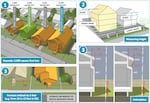
A multi-family home in Portland. The Residential Infill Project aims to promote the construction of such homes.
Marianne Madden
The city of Portland is considering whether to change zoning rules to create more room to build affordable housing and accommodate future growth. But a
has found those changes might not work.
Portland's Residential Infill Project would change residential zones that only allow single-family homes to allow duplexes and triplexes. They compose the city's so-called "missing middle" between houses and large apartment buildings. The study on the Project commissioned by the city found that new, denser housing would be more affordable.

The Residential Infill Project would change zoning rules in areas currently zoned for single-family homes to allow duplexes and triplexes as well.
Portland Bureau of Planning and Sustainability
The math isn’t complicated: If a developer can fit a duplex onto one plot of land, they don’t need to ask for as much money for each unit to recoup their costs and turn a profit. Buyers wind up paying more per square foot, because the units are smaller, but less overall for an individual unit.
There's a catch, though. The Residential Infill Project would also reduce the maximum size of houses that can be built in residential zones. This change is a response to criticism that Portland's newer homes, which are often much bigger than the homes they replace, are monolithic "McMansions."

The Residential Infill Project would reduce the maximum size of houses, called the floor area ratio (FAR), allowed in certain residential zones. It would also reduce the maximum height of some homes and increase the required setback from the sidewalk.
Portland Bureau of Planning and Sustainability
Jerry Johnson, principal of Johnson Economics, wrote the study. He says that reducing the allowed maximum size of homes would make redeveloping homes less appealing to developers.
“Reduction in supportable values related to the reduction in allowable square footage, actually made it less economically rewarding to develop sites.” Johnson said. “So while more units are allowed, they’re less lucrative to do, so we’d expect a lower quantity of them to be done by the market.”
The Residential Infill Project would make housing in Portland more affordable, but not because it would flood the market with duplexes and triplexes. Rather, the changes made by the project would suppress homes’ value to developers who want to redevelop them. It wouldn’t create additional affordable units so much as it would keep existing homes affordable by discouraging redevelopment.
Where Portland will fit the 123,000 new households expected in the city by 2035 remains an open question. The Bureau of Planning and Sustainability will brief the City Council on the report and the Residential Infill Project on Tuesday, Nov. 2 at 9:30 a.m.